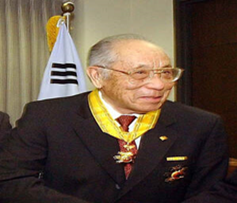About Lesson
Lesson 5: Young Oak Kim: Hero and Humanitarian

Young Oak Kim in 1961.
(Source: WIkipedia)
Lesson Features
-
- TOPICS: World War II, racism, characteristics of a hero
- HISTORICAL TIMEFRAME: 1940 – 1990
- HIGHLIGHTED KOREAN AMERICANS: Young Oak Kim
- SUMMATIVE ASSESSMENT: Argument Essay
Lesson Overview
-
- Students explore the life of Young Oak Kim, and identify contributions he has made to the United States. They complete a Think/Write/Pair Share/Group Share as they reflect on what it is like to be a Korean American/minority struggling through racial barriers like Young Oak Kim. They explore what kinds of microaggressions Kim encountered and consider how he responded to those actions. Students deepen their understanding of the life of Young Oak Kim as a U.S. citizen, war hero and community activist, and they annotate and discuss an excerpt from the biography, Unsung Hero: The Colonel Young O. Kim Story, by Woo Sung Han. They construct a biopoem and/or an argument essay on his life and contributions to American society.
Lesson Assessments and Activities
-
- Lesson 5 Alignment with Standards
- Activity 5.1: Who was the First Asian American to Command a U.S. Battalion?
- Activity 5.2: How is Colonel Young Oak Kim an Unsung Hero?
- Lesson 5 Assessments and Extensions
Timeframe
-
- Activity 5.1 and 5.2 each require 55 minutes plus additional time for polishing the biopoem.
- The Summative Assessment Comparison/Contrast Essay will also require at least one 55-minute period plus homework.
Objectives and Learning Goals
-
- Students will be able to identify characteristics of Young Oak Kim that make him a hero.
- Students will be able to identify racism and microaggression acts in Young Oak Kim’s experiences as well as their own.
- Students will be able to construct a biopoem from texts (print, video, and audio).
- Students will be able to compose an argument regarding Young Oak Kim’s contributions to the Japanese American community, as well as to the progress of civil rights of all racial minority communities in the United States.
Vocabulary
-
- War hero – a person who is admired for bravery in war.
- Humanitarian – a person who seeks to promote human welfare; a philanthropist.
- World War II – World War II, also called Second World War, conflict that involved virtually every part of the world during the years 1939–45. The principal belligerents were the Axis powers—Germany, Italy, and Japan—and the Allies—France, Great Britain, the United States, the Soviet Union, and, to a lesser extent, China.
- Korean War – Korean War, conflict between the Democratic People’s Republic of Korea (North Korea) and the Republic of Korea (South Korea) in which at least 2.5 million persons lost their lives. The war reached international proportions in June 1950 when North Korea, supplied and advised by the Soviet Union, invaded the South.
- Asian American – an American who is of Asian (in particular East Asian) descent.
- Ethnicity – the fact or state of belonging to a social group that has a common national or cultural tradition.
- U.S. Army – The United States Army is the land service branch of the United States Armed Forces. It is one of the eight U.S. uniformed services, and is designated as the Army of the United States in the U.S. Constitution.
- Multicultural – relating to or constituting several cultural or ethnic groups within a society.
- Multiethnic – relating to or constituting several ethnic groups.
- Racial divide – division of humans by race.
- Racism – prejudice, discrimination, or antagonism directed against a person or people on the basis of their membership in a particular racial or ethnic group, typically one that is a minority or marginalized.
- Microaggression – indirect, subtle, or unintentional discrimination against members of a marginalized group.
Original Resource
-
- Chang, E. & Shin, F. (2022). Young Oak Kim: Hero and Humanitarian. In G. Cho & V. Costa (Eds.). Korean American Ethnic Studies Curriculum: Teaching Resource Materials for K-12 Classrooms (pp.223-274). Consulate General of the Republic of Korea in Los Angeles.
Lesson 5 Presentation (PDF)
Lesson 5 Presentation Teacher’s Guide (PDF)
Download Lesson 5 Presentation (PPT)

